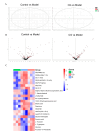Calycosin-7-O-β-D-Glucoside Ameliorates Palmitate-Induced Lipid Accumulation in HT22 Cells
- PMID: 39403908
- PMCID: PMC11475025
- DOI: 10.62641/aep.v52i5.1723
Calycosin-7-O-β-D-Glucoside Ameliorates Palmitate-Induced Lipid Accumulation in HT22 Cells
Abstract
Background: The pathogenesis of Alzheimer's disease (AD) is complex. Recent research suggests that AD patients have early disorders in brain cholesterol metabolism. Cholesterol and its derivatives accumulate in neurons, leading to p-Tau overproduction and synaptic dysfunction, initiating AD progression. Calycosin-7-O-β-D-glucoside (CG), a distinctive constituent of Astragali Radix, holds a representative position. Many clinical trials have demonstrated that CG can attenuate cerebral ischemia/reperfusion injury and preserve the structural integrity of the blood-brain barrier. However, whether CG alleviates tau-mediated neurodegeneration by increasing cholesterol efflux after lipid accumulation remains unexplored.
Methods: Ultra-performance liquid chromatography/quadrupole time-of-flight mass spectrometry (UPLC-Q-TOF-MS/MS) and multivariate data analysis were employed to investigate metabolic changes in HT22 cells induced by sodium palmitate following 24 hours of CG treatment. The potential therapeutic mechanisms of CG on AD were further examined through Kyoto Encyclopedia of Genes and Genomes (KEGG) pathway enrichment analysis.
Results: Metabolomic analysis characterized 24 potential biomarkers, revealing that CG could ameliorate cholesterol metabolic pathways. The results of cell experiments revealed that CG can increase the expression of enzyme cholesterol 24-hydroxylase (CYP46A1) (p < 0.05) and the level of 24 hydroxycholesterol (24-OHC) (p < 0.05), reduce the expression of p-Tau (Thr231)/Tau (p < 0.01), inhibit the formation of lipid droplets.
Conclusion: CG may inhibit the accumulation of cholesterol and its derivatives in neurons by affecting the CYP46A1-CE-Tau axis, offering a potential therapeutic strategy for AD.
Conflict of interest statement
The authors declare no conflict of interest.
Figures




Similar articles
-
Calycosin-7-O-β-D-glucoside attenuates palmitate-induced lipid accumulation in hepatocytes through AMPK activation.Eur J Pharmacol. 2022 Jun 15;925:174988. doi: 10.1016/j.ejphar.2022.174988. Epub 2022 Apr 29. Eur J Pharmacol. 2022. PMID: 35490724
-
Calycosin-7-O-β-D-glucoside regulates nitric oxide /caveolin-1/matrix metalloproteinases pathway and protects blood-brain barrier integrity in experimental cerebral ischemia-reperfusion injury.J Ethnopharmacol. 2014 Aug 8;155(1):692-701. doi: 10.1016/j.jep.2014.06.015. Epub 2014 Jun 12. J Ethnopharmacol. 2014. PMID: 24930357
-
Calycosin-7-O-β-D-glucoside Attenuates OGD/R-Induced Damage by Preventing Oxidative Stress and Neuronal Apoptosis via the SIRT1/FOXO1/PGC-1α Pathway in HT22 Cells.Neural Plast. 2019 Dec 1;2019:8798069. doi: 10.1155/2019/8798069. eCollection 2019. Neural Plast. 2019. PMID: 31885537 Free PMC article.
-
Therapeutic potentials of plant iridoids in Alzheimer's and Parkinson's diseases: A review.Eur J Med Chem. 2019 May 1;169:185-199. doi: 10.1016/j.ejmech.2019.03.009. Epub 2019 Mar 8. Eur J Med Chem. 2019. PMID: 30877973 Review.
-
The Controversial Role of 24-S-Hydroxycholesterol in Alzheimer's Disease.Antioxidants (Basel). 2021 May 7;10(5):740. doi: 10.3390/antiox10050740. Antioxidants (Basel). 2021. PMID: 34067119 Free PMC article. Review.
References
-
- Olloquequi J, Ettcheto M, Cano A, Sanchez-López E, Carrasco M, Espinosa T, et al. Impact of New Drugs for Therapeutic Intervention in Alzheimer’s Disease. Frontiers in Bioscience (Landmark Edition) . 2022;27:146. - PubMed
-
- Lane CA, Hardy J, Schott JM. Alzheimer’s disease. European Journal of Neurology . 2018;25:59–70. - PubMed
-
- Dai L, Zou L, Meng L, Qiang G, Yan M, Zhang Z. Cholesterol Metabolism in Neurodegenerative Diseases: Molecular Mechanisms and Therapeutic Targets. Molecular Neurobiology . 2021;58:2183–2201. - PubMed
MeSH terms
Substances
LinkOut - more resources
Full Text Sources

